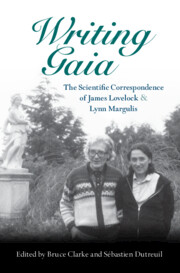Book contents
- Writing Gaia: The Scientific Correspondence of James Lovelock and Lynn Margulis
- Reviews
- Writing Gaia: The Scientific Correspondence of James Lovelock and Lynn Margulis
- Copyright page
- Epigraph
- Table of Contents
- Figures
- Contributors
- Foreword by James Lovelock
- Preface
- Acknowledgements
- Introduction
- Part I 1970–1972
- Part II 1973–1979
- 1973
- 1974
- 1975
- 1976
- 1977
- 1978
- 1979
- Part III 1980–1991
- Part IV 1992–2007
- Part V Commentaries on Lovelock and Margulis
- Glossary of Names
- Glossary of Terms
- Bibliography
- Index
1979
from Part II - 1973–1979
Published online by Cambridge University Press: 28 July 2022
- Writing Gaia: The Scientific Correspondence of James Lovelock and Lynn Margulis
- Reviews
- Writing Gaia: The Scientific Correspondence of James Lovelock and Lynn Margulis
- Copyright page
- Epigraph
- Table of Contents
- Figures
- Contributors
- Foreword by James Lovelock
- Preface
- Acknowledgements
- Introduction
- Part I 1970–1972
- Part II 1973–1979
- 1973
- 1974
- 1975
- 1976
- 1977
- 1978
- 1979
- Part III 1980–1991
- Part IV 1992–2007
- Part V Commentaries on Lovelock and Margulis
- Glossary of Names
- Glossary of Terms
- Bibliography
- Index
Summary
In Letter 109, Lovelock responded to Margulis’s invitation to join her team on a field excursion to Baja California: “An expedition to Baja sounds marvellous. But when? and from whence could come some funds?” A year later, Margulis used her selection as a Guggenheim Foundation Fellow to support a research group studying early life on Earth at Laguna Figueroa, Baja California Norte, Mexico. Letter 115 indicates that Lovelock joined the party that spring, after which Margulis expressed her delight with Lovelock’s participation in this recent excursion: “It was a pleasure to see you so healthy. The trip was a highlight for me of my career.” This allows us to put a date on the trip he recounts in Homage to Gaia: A high spot of this period was an expedition organised by Lynn, who gathered the funds to enable a party of scientists to visit Baja California and do research on the algal mats there … I watched as Lynn cut out with a small spade a cube of the mat four inches in size. We looked at its banded structure: each band was a different community of micro-organisms segregated according to the flow of nutrients and oxygen. Lynn showed how similar was this banded structure to that of the fossil mats over two billion years ago. I was convinced by her lucid explanations that micro-organisms are the heart of Gaia and always have been.
- Type
- Chapter
- Information
- Publisher: Cambridge University PressPrint publication year: 2022

